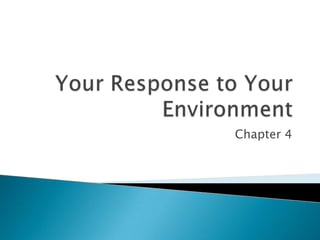
Chapter 4 your response to your environment
- 1. Chapter 4
- 2. Explain the theories of Erikson, Havighurst, Maslow, and Kohlberg concerning personal development. Describe the use of defense mechanisms in responding to your environment. Explain various types of personal response patterns.
- 3. Every situation in your life requires you to respond to your environment. Many theories have been formed concerning the development of humans and their personalities.
- 4. Erikson’s theory is that personality development is affected by each of eight stages in the life cycle. In each Stage, a person confronts certain crises that must be resolved before moving to the next stage.
- 5. Occurs during infancy and establishes our most basic sense of trust. Consistent love & attention → confidence and trust. Unloved or abused → insecure and mistrustful.
- 6. Occurs between ages one and four Children begin to experience autonomy. Autonomy – the freedom of self- direction
- 7. Reach this stage around four or five. Initiative – desires to begin action. Children begin to develop imagination and begin to do things on their own.
- 8. From ages six to twelve. They learn that work is worthwhile and meaningful. Inferiority – feeling unimportant or inadequate.
- 9. Occurs during adolescence Identity – knowing who you are As adolescents gain maturity, they begin to view life and the world around them differently.
- 10. The sixth stage is concerned with establishing a sense of intimacy with others. Young adults who succeed in this stage have accepted themselves as worthwhile persons.
- 11. In the seventh stage, adults develop a sense of generativity. Generativity – Concern for future generations
- 12. A sense of integrity develops in people who succeed in the final stage of development. Integrity – A state of being complete. The person is satisfied with his or her life.
- 13. Havighurst identified developmental tasks that people perform as they grow. Success in these tasks leads to happiness and success in other developmental tasks they will perform later in life. Failure leads to unhappiness, disapproval by society, and difficulty with later developmental tasks.
- 14. Becoming more adult Deciding on roles Accepting your physical self Becoming more independent Preparing for marriage and family life Selecting an occupation Developing personal priorities Becoming more socially responsible
- 15. Because you are human, you have certain needs. You share these needs with all other humans, but you fulfill them in unique ways. In Maslow’s system, he arranged needs in order of their priorities.
- 16. Physical Needs
- 17. Physical needs have first priority. Fulfillment of physical needs is necessary for good health, a state of well-being, and the continuation of life.
- 18. Once you have satisfied your physical needs, you can address other needs. You need to feel safe from physical danger. You need to feel secure in daily routines so you know what to expect from life.
- 19. Everyone needs to be needed. You need to feel that you are accepted by others, and you need to feel secure in your relationships.
- 20. You need esteem (respect and admiration). Self-esteem must be established first. You must respect yourself first before you can expect others to respect you.
- 21. Self-actualization is the realization of your full potential. To reach this level, all other levels of needs must be at least partially fulfilled.
- 22. Kohlberg believed that people pass through a series of predictable stages in their moral thinking. Morals – Beliefs about right and wrong behavior.
- 23. Preconventional Level: Moral decisions are based on punishment & rewards. ◦ Stage 1 – Threat of punishment influences decisions ◦ Stage 2 – Desire for rewards influences decisions
- 24. Conventional Level: Moral decisions are based on social rules and expectations. ◦ Stage 3 – Opinions of others influence decisions ◦ Stage 4 – Respect for law and order guides behavior
- 25. Postconventional Level – Moral decisions are based on personal ethics concerning what is morally right ◦ Stage 5 – Personal priorities concerning individual human rights influence decisions ◦ Stage 6 – Self-chosen ethical principles guide decisions
- 26. Each time something happens in your environment to threaten your self- esteem, you react. Defense Mechanisms – Ways that people may react, almost automatically, to anxiety- producing events or threats.
- 27. Direct attack – In response to a threat to your self-esteem, you attack the source of your threat. Compensation – Using a substitute method to achieve a desired goal. Rationalization – When you explain your weaknesses or failure by giving socially acceptable excuses
- 28. Projection – When you blame other people or things for your failures. ◦ Scapegoat – The person who bears the pain for the others; taking the blame for something you didn’t do.
- 29. Displacement – Transferring an emotion connected with one person or thing to an unrelated person or thing. Conversion – Transferring the energy of desire you cannot express into a physical symptom or complaint
- 30. Regression – A defense mechanism in which you revert back to a less mature stage of development. Idealization – Valuing something far more than its worth. ◦ Something in your life that means a lot to you even if its not worth anything.
- 31. Daydreaming Giving Up
- 32. Anger Fear Depression Attitudes Prejudices – An opinion formed without knowledge. Stereotypes – The false belief that all members of a given group are the same.